What is Rain Water Harvesting?
What is Rain Water Harvesting?
It is to catch the rain, store and use. Rain water harvesting is defined as collection of run-off rainwater for domestic use, agriculture, soil conservation, and environmental management . Rain water collected from roof top is stored for human use and run off rain water from land surfaces or rock catchments are collected for agriculture use or for ground water recharging.
Reliability of rain water supply depend on the size of the catchment area, (the roof), the volume of the storage tank and the management of daily consumption, all in relation to the local rainfall pattern. In Sri Lanka where the annual average rain is relatively high rain water harvesting is technically feasible any where.
Rain water can be harvested for two purposes
- Storing rainwater for ready to use in containers above or below ground
- Charged into the soil for withdrawal later (groundwater recharging)
Where can rain water harvesting be used?
- All zones of Sri Lanka has a potential for rain water harvesting, but particularly it is suited for dry zone where groundwater is mineralized, coastal belt where groundwater is saline, hilly areas were groundwater table is low where it is not possible to extract ground water or have no other water sources
- In urban areas as a supplementary source for gardening, car washing, fire fighting, toilet flushing
- Factories, hospitals and Institutions where there is large roof areas and large use of water.
How much water can be collected?
To estimate the amount of rain water harvested, you can use the below simple equation.
𝑅𝑊𝐻 𝑝𝑜𝑡𝑒𝑛𝑡𝑖𝑎𝑙 = 𝐶 ∗ 𝐼 ∗ 𝐴𝑟—— Eqn. 1
Where C = coefficient of runoff ((this varies between 0.5 and 0.9 depending on roof material and slope)
𝐼 = Mean rainfall (mm)
𝐴𝑟 = roof top area (m2)
How to calculate the amount of rain water you can collect from your roof please use the following link
http://www.lankarainwater.com/edit/calculator/
Next step to designing RWH system will be to size the water tank correctly to give adequate storage capacity. The storage requirement will be determined by a number of interrelated factors. They include:
- local rainfall data and weather patterns
- size of roof (or other) collection area
- runoff coefficient
- user numbers and consumption rates
A very simple method is to calculate the largest storage requirement based on the consumption rates and occupancy of the building.
As a simple example we can use the following typical data:
Consumption per capita per day, C – 20 litres
Number of people per household, n – 6
Longest average dry period – 25 days
Daily consumption = C x n = 120 litres
Storage requirement, T = 120 x 25 = 3,000 litres
Rain water usage in urban areas
In Sri Lanka increasing population has imposed a considerable strains on the water resources and the urban authorities find it extremely difficult to expand their water supply schemes not only due to financial constraints but also due to limited water resources. In urban areas where pipe water supply is present RWH can
- Supplementary source in households for toilet flushing, gardening, washing, laundry ect
- Reduce water bills and cost of treatment to the government.
- Use in factories/ public building and commercial buildings where there is large use of water and have large roof area.
- As emergency water in fire fighting
- Reduce flooding and storm drainage which is experience by many cities due to increased paved and concrete areas preventing rainwater permeating underground.
- Directed to recharge the aquifer thus increasing the depleted ground water table.
Technology
Two sources or catchments of harvesting of rainwater –
- Rooftop harvesting
- Runoff harvesting
Elements of a typical Water harvesting System.
Following structures are the basic requirement for a typical Rain water harvesting structures
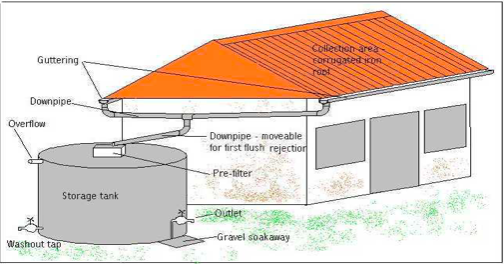
Fig. 1 Components of the rain water harvesting system
- Catchments: of a rain water harvesting system is the surface, which receive rain fall directly and contribute the water to the system. This can be the roofs in a rooftop system and the driveway, landscape or any other surface in a runoff system.
- Delivery system : Gutters and pipes are pipelines and drains that carry rain water from the catchment or roof top to the rain water harvesting storage tank. Gutters and pipes can be of PVC, concrete or galvanized iron.
- Storage facility:
- Rain water can be stored in any commonly used water storage containers such as Reinforced Cement Concrete, masonry Fiber glass or plastic( PE). Storage can also be in dug out ponds lined/unlined or constructed.
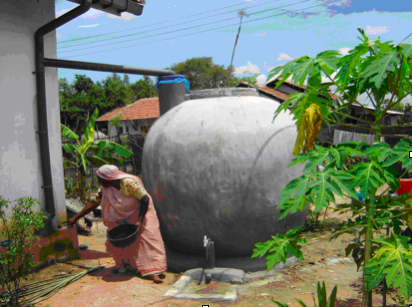
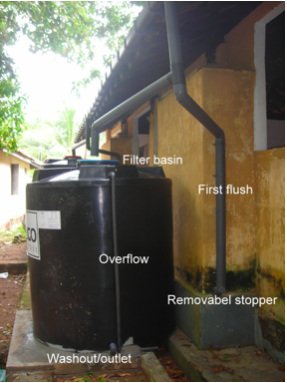
Above ground Ferocement tank and PE tank Rain water system
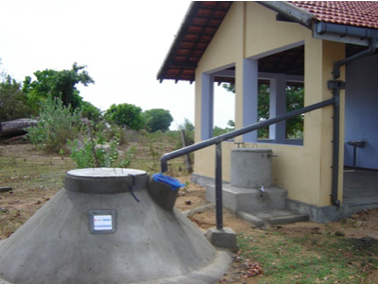
Under ground brick tank
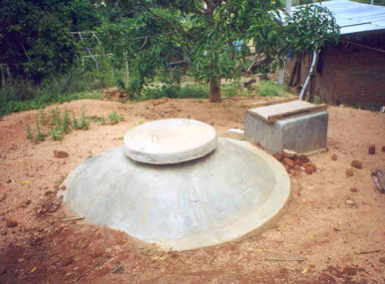
Partially underground Tank
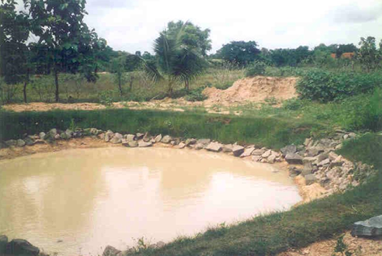
Un-line run off tank
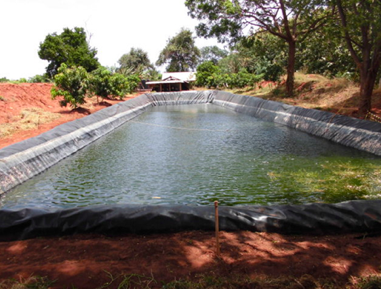
Lined run off tank
- Recharge facility: Rain water can also be charged into the ground water aquifer. This can be done through any suitable structure like dug wells, borewells, recharge trenched and recharge pits.
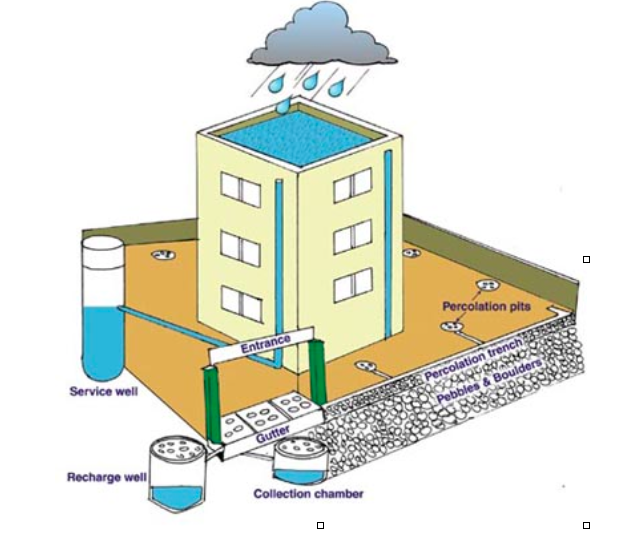
- Extraction device: stored water is extracted by tap if the storage tank is places above or on the ground or by hand pump or electric pump if the storage is under ground.
Benefits of Rain water Harvesting
The benefits are easy to quantify. As an economic investment, RWH installations pay off the cost of installation in 2 years or less. This means that after the 3rd year, you get FREE water FOREVER. If you recharge the ground water with rain water, you are assured of good water supply either after one or two rainy seasons. A study of urban households in Sri Lanka has revealed that the money spend on water can be reduced by about 30-60% per month by using rain water.
Other benefits are:
- Clean water source for all domestic purposes including drinking in water scares area ( Chronic Kidney Disease effected)
- Supplementary source in households for toilet flushing, gardening, washing, laundry ect
- Use in factories, public building, hospitals and schools where there is large use of water and have large roof area.
- As emergency water in fire fighting
- Climate Change effect mitigation measure ( floods and droughts)
- Recharge the aquifer thus increasing both the quality and quantity of the ground water table.
- Energy Saving ( reduction in cost of water treatment and pumping)
Cost of water harvesting
The cost of the implementation of rain water harvesting system in a house/flat will depend on the size of the premises, number and location of the rooftop pipes, nature of the soil as well as on the availability of an open well. Typical installation of water harvesting system in a building would cost between Rs. 1000 to 50,000 for building of about 300 sq m. the cost would be less if incorporated during the construction of building itself. If an open well exists in the site then recharging will not be necessary and the cost will be less.
Health Measures
Rain water is clean but it can get contaminated by air pollution or surface contamination.
- Rain water collected in urban areas is generally considered not suitable for drinking or cooking due to dust, air pollution and other pollutants.
- Steps should be taken to keep the rooftops clean, if the water collected is used directly.
- The diversion valve or the first flush device can be used to remove the first 20 to 30 minutes ( 2 mm) of rainfall carrying contaminate to be discarded.
- Contaminations like silt, sand blown dirt can removed by sedimentation and filtration
- Steps should be taken to keep the storage facilities like underground tank, above ground tank etc. tightly closed to avoid mosquito breeding.
- Biological contamination, if any can be removed by, disinfection the water by boiling, chlorination, Solar water disinfection.
